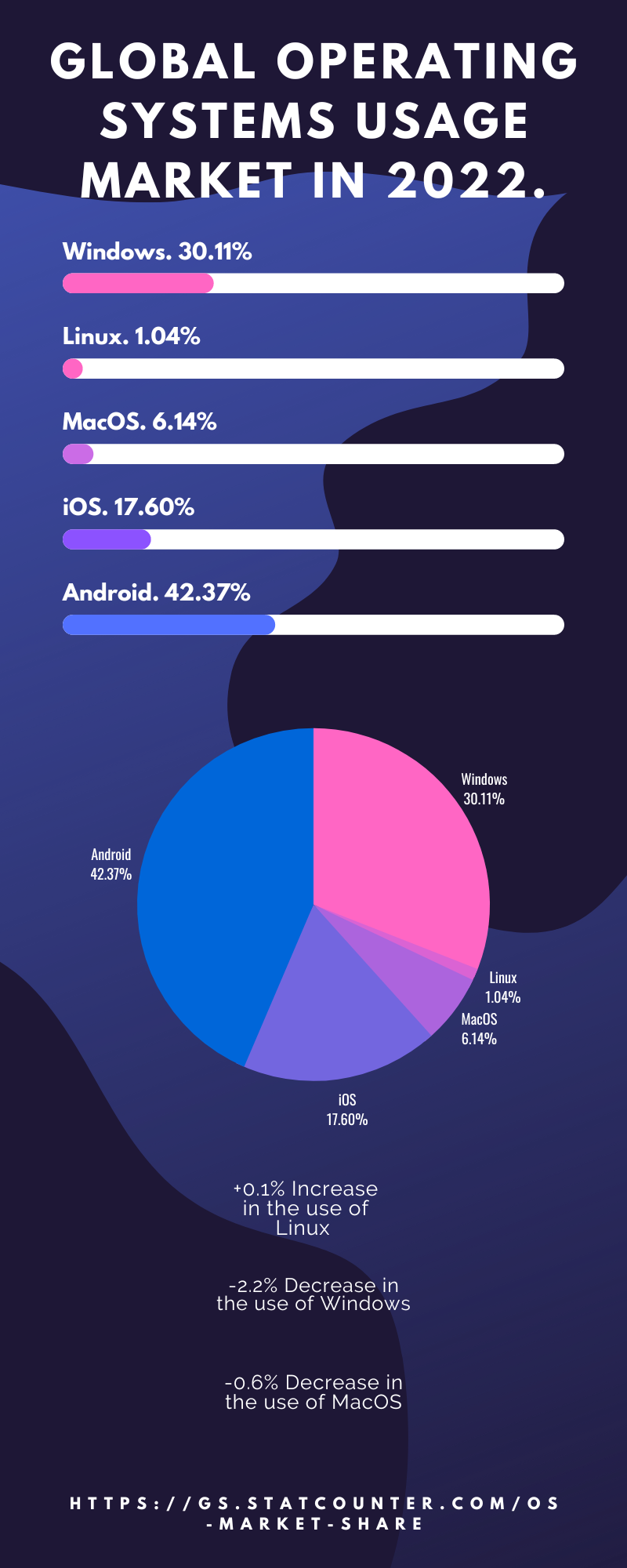Submitted by Disastrous-Focus1958 t3_yzgshg in dataisbeautiful
Comments
1selfharm t1_iwzu02i wrote
Also android is based on Linux too
Own-Cupcake7586 t1_iwzu35e wrote
Desktop OS usage, surely. Supercomputers and servers are dominated by Linux.
delicatearchcouple t1_ix0196l wrote
Just rich people looking to be part of the club.
toastyroasties7 t1_ix04ujg wrote
Surely there are many times more personal devices than servers?
Brewe t1_ix13l4p wrote
There aren't billions of servers, but there are billions of PCs and mobiles.
Brewe t1_ix13zq7 wrote
A few very minor questions:
Why did you choose that order?
What constitutes an instance of an operating system usage? Are Raspberry PIs counted? what about servers? consoles? smart fridges?
eric5014 t1_ix1fr1x wrote
I suspect this is not counting the total number of devices (how would you do that?) but counting internet traffic. When you visit a website their server can see what browser and OS you have, so websites can track the proportions of these over time.
The term "market share" is probably not a good one in this case, because that usually refers to what people are paying for. Part of the appeal of Linux (inc Android) is that it's free.
I'm on Linux, so I guess I'm in the 1%, though I have Windows as well. Oh, and three Linux servers and two Android devices.
Disastrous-Focus1958 OP t1_ix1fyiy wrote
Linux is obviously the king of servers. The graph looks at desktop users.
Disastrous-Focus1958 OP t1_ix1gfgh wrote
>Why did you choose that order?
There is no particular order, it was random.
>What constitutes an instance of an operating system usage? Are Raspberry
PIs counted? what about servers? consoles? smart fridges?
It is constituted by the daily use of the system on the desktop.Devices such as consoles, servers, and other IoT, do not count since most of them are composed of Linux and BSD. (They also do not fit in the desktop category).
[deleted] t1_ix1ggjf wrote
[removed]
Disastrous-Focus1958 OP t1_ix1gji6 wrote
Thanks for the annotation, I forgot to clarify that the measurement is purely for desktop use.
Disastrous-Focus1958 OP t1_ix1gn34 wrote
Windows Phone and Ubuntu Touch are dead... 😅
Disastrous-Focus1958 OP t1_ix1h3o5 wrote
I agree that the term "market" is not quite correct if we become somewhat fundamentalist, however it is a term that attempts to clarify user preference among the different options offered.
Consoles, servers, IoT, and so on don't count. These devices are mostly composed of BSD and Linux, and the chart only focuses on desktop users.
P.S: I am also part of the 1% of Linux ;)
st4n13l t1_ix1hrum wrote
Development may be dead but the OSes are still in use. I assume you're saying the numbers aren't included in the Windows/Linux numbers?
[deleted] t1_ix1hygg wrote
st4n13l t1_ix1i5gl wrote
>The graph looks at desktop users.
iOS and Android aren't desktop OSes
Disastrous-Focus1958 OP t1_ix1lfeq wrote
People use tablets and ARM laptops to do desktop work. Office is for Android and iOS, so they are included there.
eric5014 t1_ix1lxpw wrote
"Browser users" or "browser traffic" is what it's counting I think.
Another one of their graphs shows this as 40% desktop, 58% mobile, 2% tablet.
This fits with Android and iOS adding up to around 60% and the desktop OSs around 40%.
noslenkwah t1_ix1umov wrote
It depends how you want to count servers. Per physical device? Per VM? Per container? Etc...
[deleted] t1_ix2cxlu wrote
[deleted]
Westcork1916 t1_ix2hjc2 wrote
I would love to see this same data for Servers alone. But servers don't browse the internet, so their presence is never captured. I would expect to see Linux with at least 50 to 60% market share. (Ubuntu user)
0anakinskywalker t1_ix2xt8z wrote
For Android, it's india china and Brazil
alexforencich t1_ix3060w wrote
Tablets are tablets, not desktops.
HOnions t1_ix3a32m wrote
Even if you add them, the graph wouldn’t change much. The number of server is ridiculously small in the grand scheme of things.
What could change it is all the lot devices and all of the « smart things »
st4n13l t1_ix3bn3r wrote
Nah, bruh
st4n13l t1_ix3byoq wrote
Even if that were your logic for including them, there's no indication that you excluded smartphones from those totals.
Furthermore, that logic would imply we should include servers in the totals as well but you have said those are excluded because this only looks at desktops. At least be consistent in your logic.
Kessarean t1_ix3xj9b wrote
Not to mention IoT as well
Kessarean t1_ix3xlha wrote
You would be surprised
ShopObjective t1_ix64nai wrote
It doesn't paint the whole picture but you could've used Steam stats to gather better desktop data.
96.5% Windows
2.23% Mac
1.28% Linux
Disastrous-Focus1958 OP t1_ix64zt4 wrote
Thanks for the suggestion, however Steam only collects information from people who use the platform. Not all desktops are used to play games or have programs associated with their launcher.
UsandoFXOS t1_ixx82dr wrote
Statcounter are focused on web traffic stats... so the most likely thing is that those analytics are considering "only" devices used by people visiting webpages.
So, maybe the title of this chart should mention that... something like "OS of devices used to view web pages".
If this is correct, then it probably there are more users using mobile devices than the counted in this analysis, because a lot of people use the smartphone never to visit web pages, but they only use apps (Facebook, YouTube,. blah blah...). 😁

Disastrous-Focus1958 OP t1_iwzsr1c wrote
I am a computer science student, interested in data science. This is the first visualization I make and share ;)